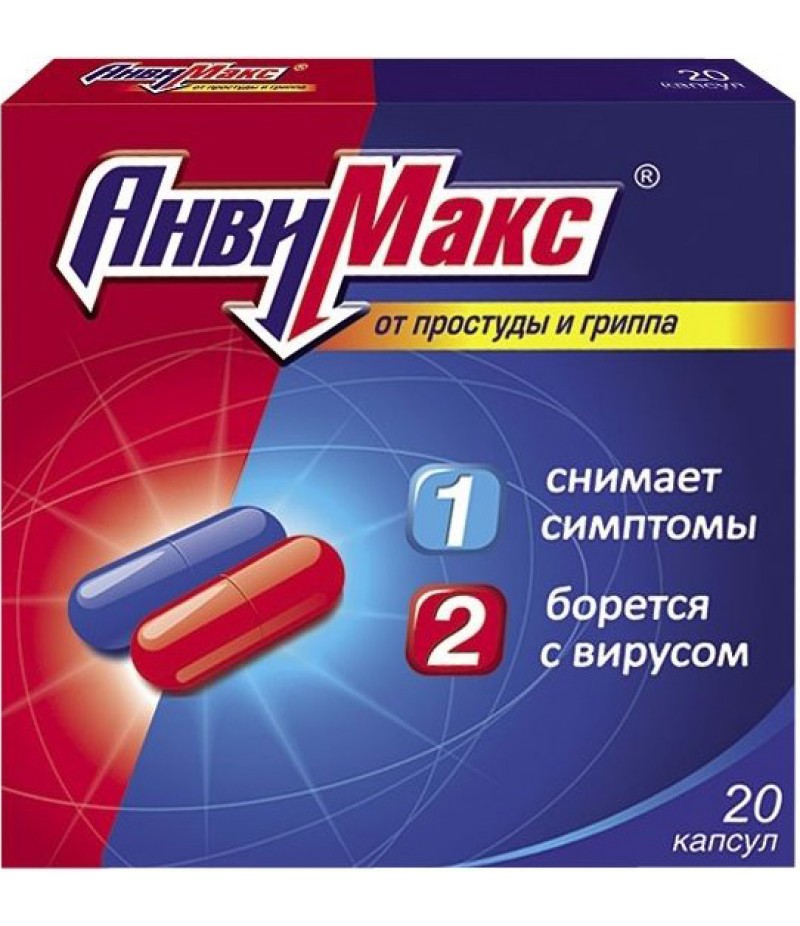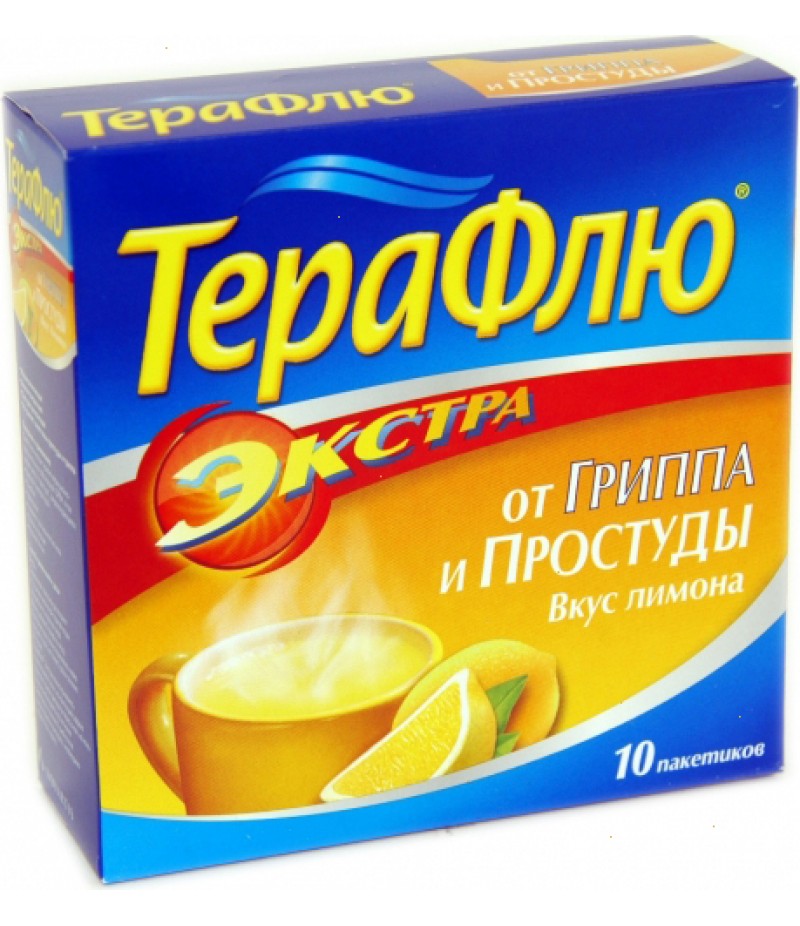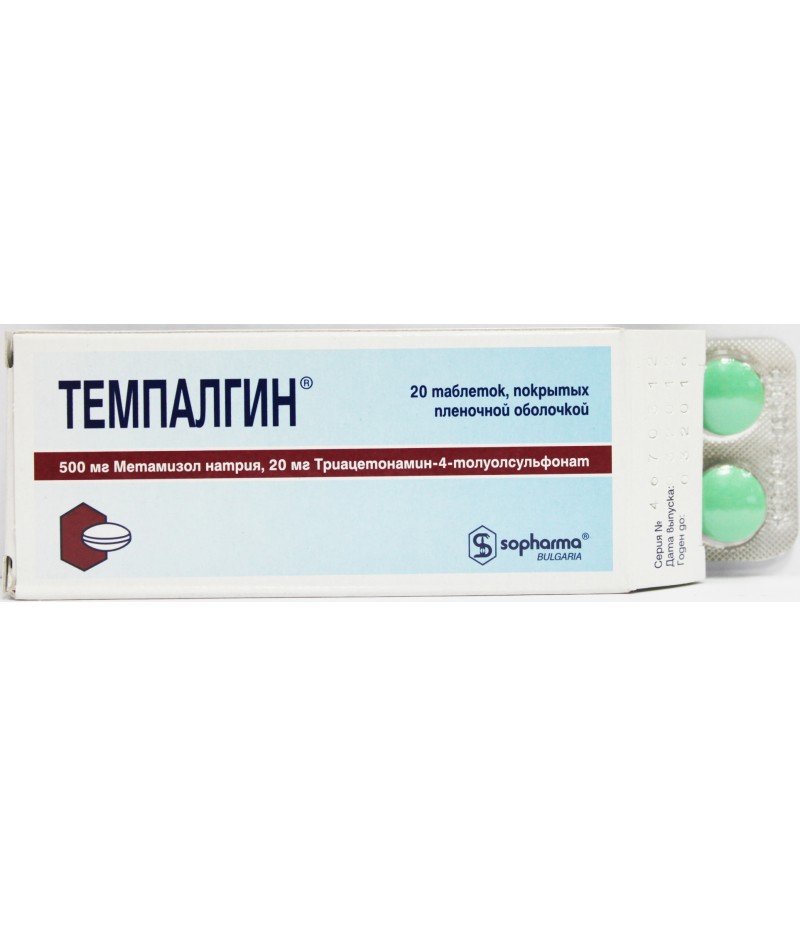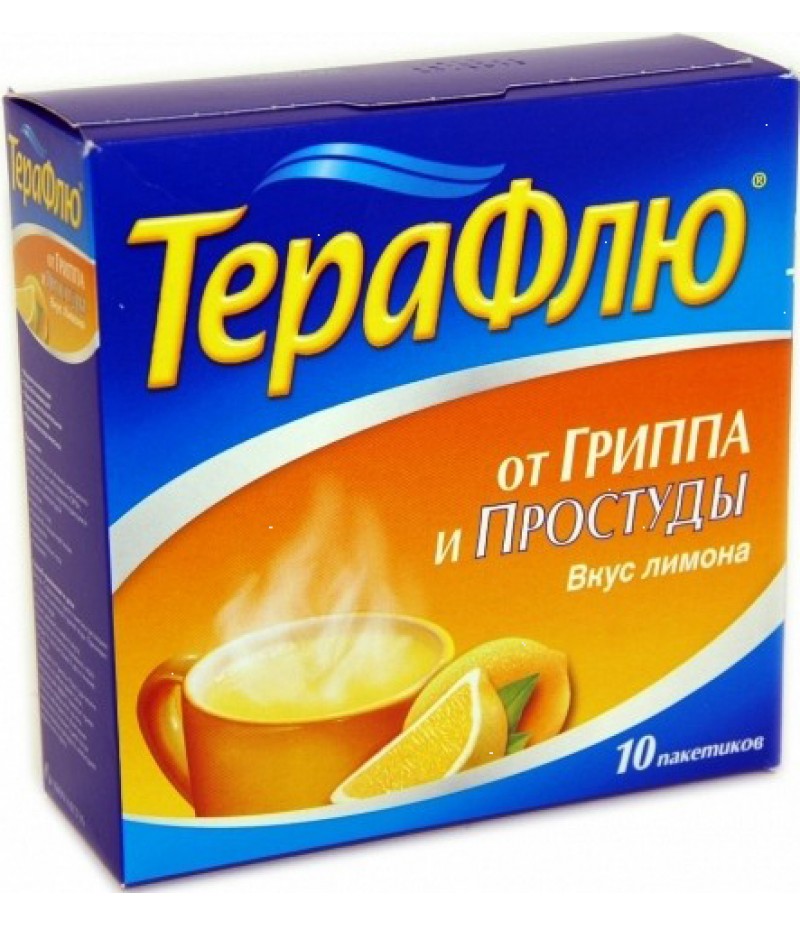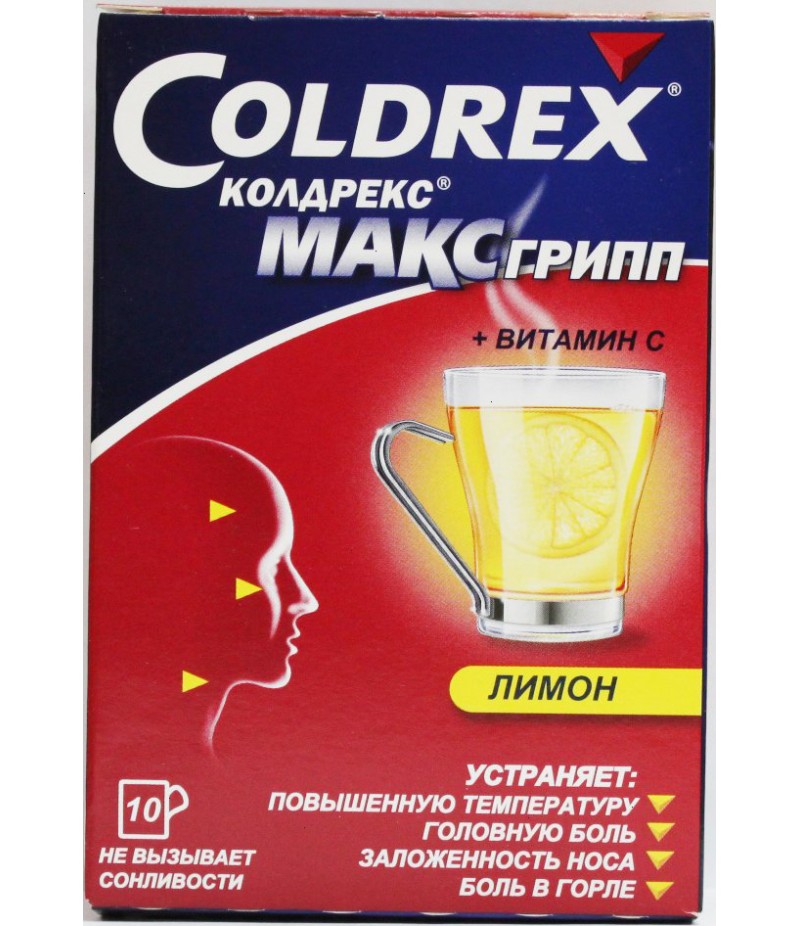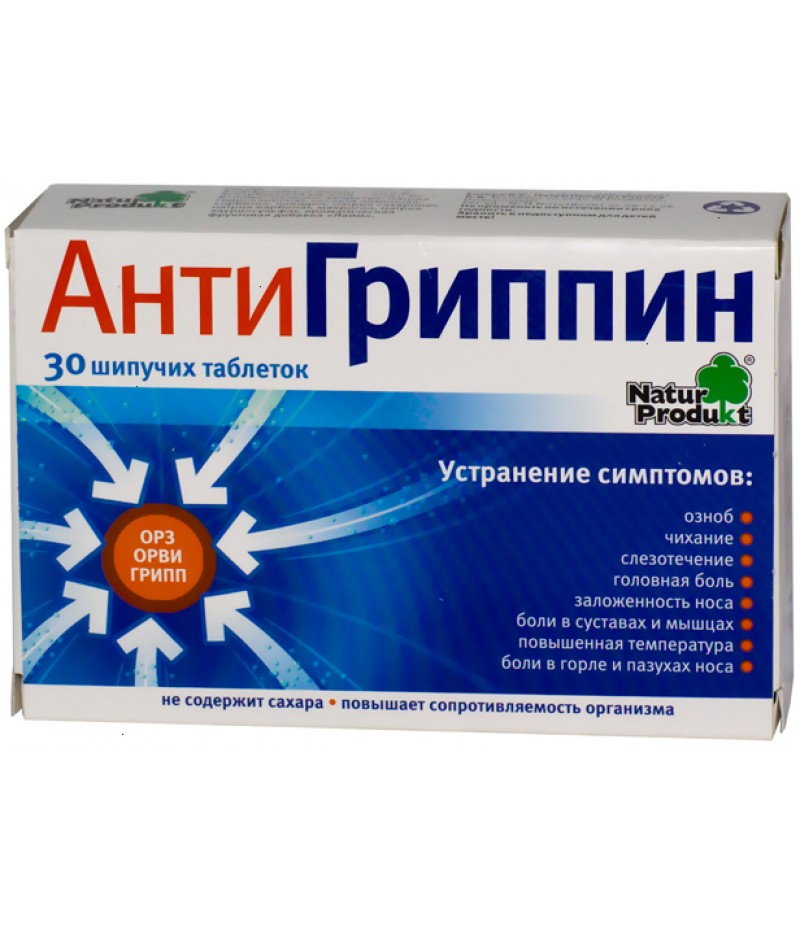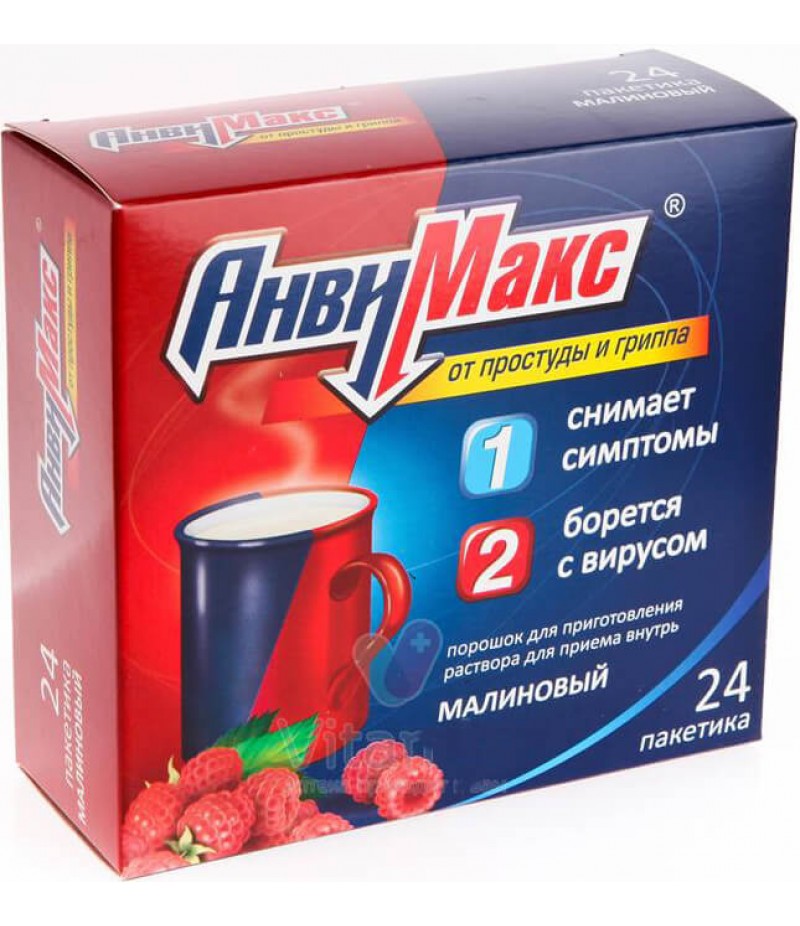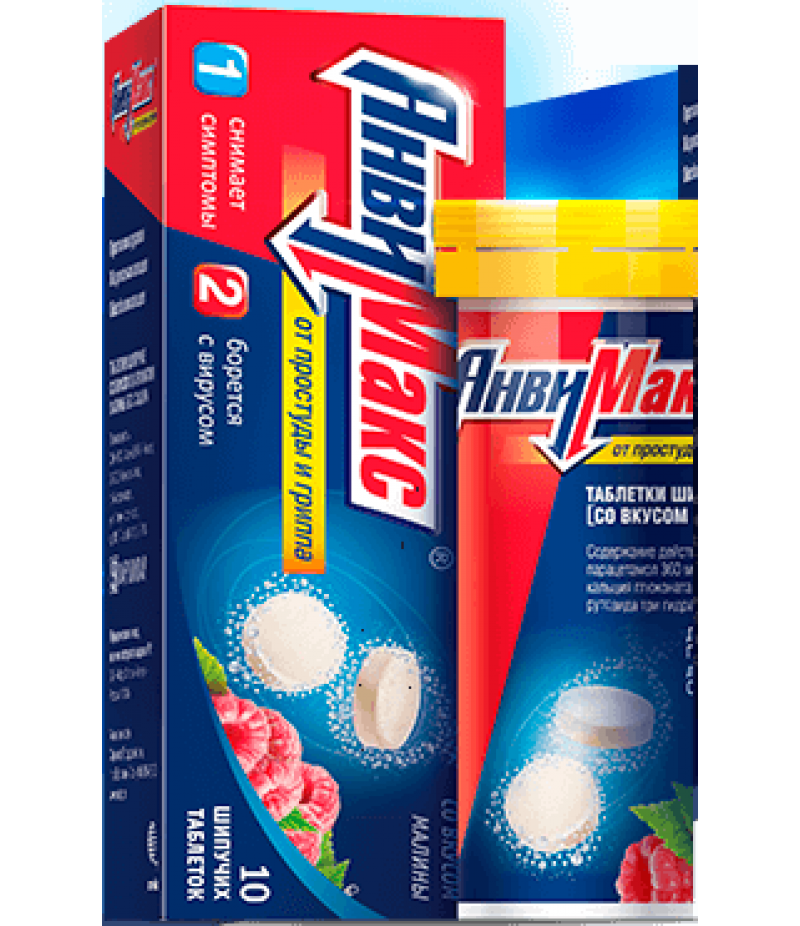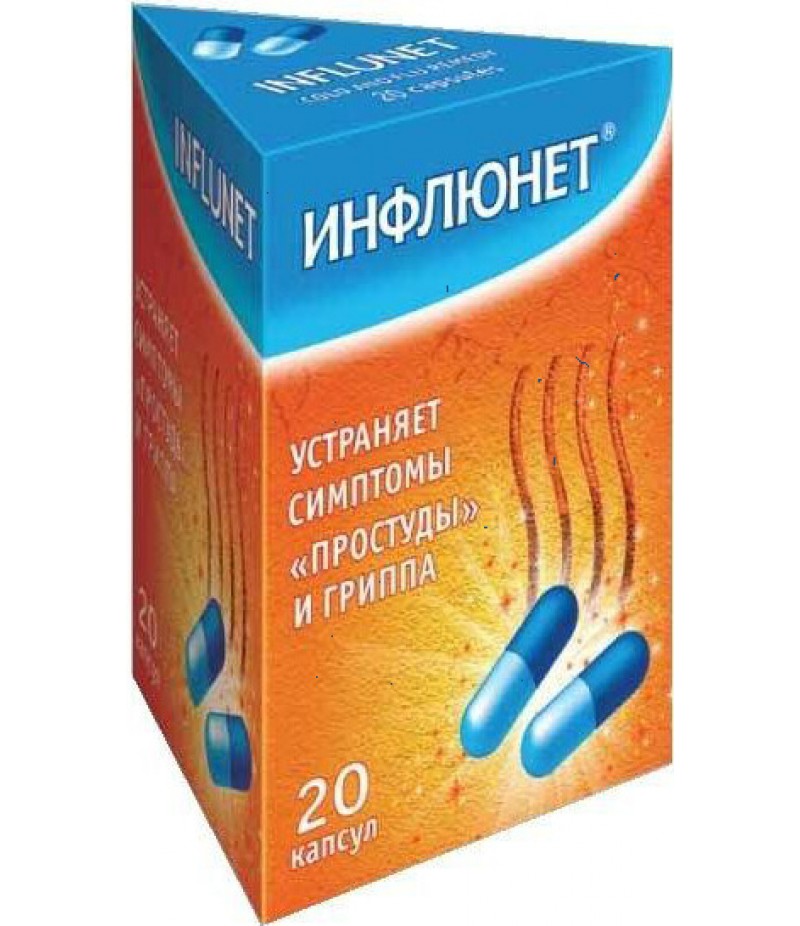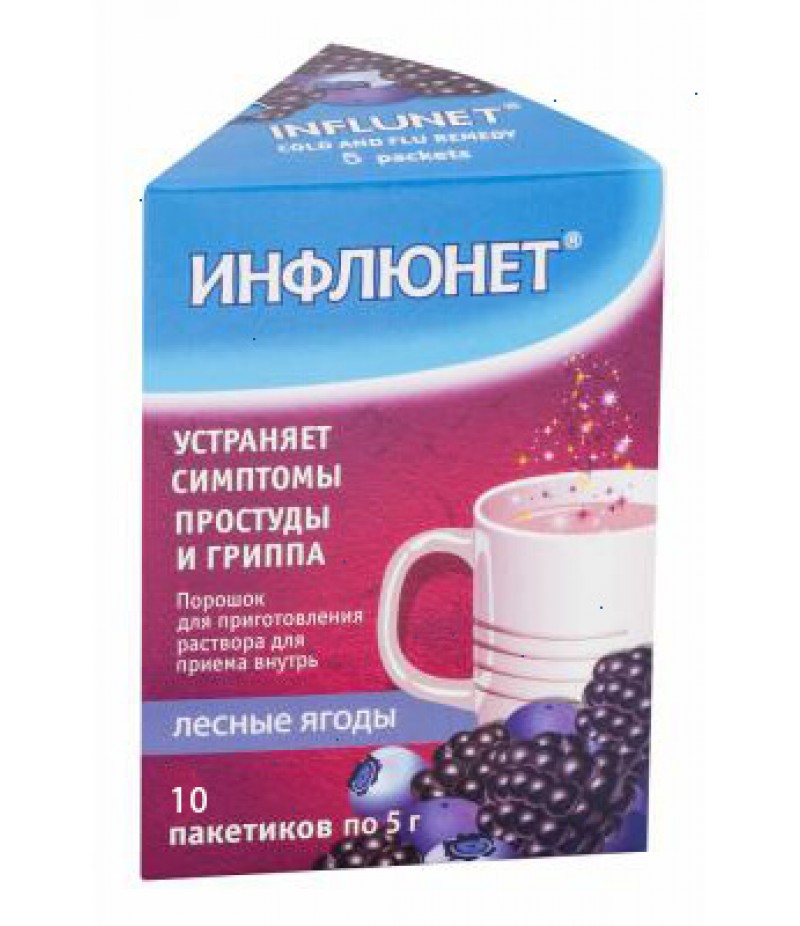AnviMax caps #20
- $14.19
- 3 or more $13.35
- Availability:In Stock
AnviMax instruction for useReed more and buy AnviMax on this pageComposition of AnviMaxThe active components of capsule P: paracetamol 360 mg; pregelatinized starch 9 mg; collo..
Tags: caps
AnviMax instruction for use
Reed more and buy AnviMax on this page
Composition of AnviMax
The active components of capsule P:
paracetamol 360 mg;
pregelatinized starch 9 mg;
colloidal silicon dioxide - 3 mg;
lactose monohydrate 4.2 mg;
magnesium stearate - 3.8 mg.
Directly capsule type P in its composition has:
gelatin - 94.795 mg;
titanium dioxide (E171) - 1.94 mg;
blue patented dye (E131) - 0.265 mg.
The composition of AnviMax in the capsule R:
ascorbic acid - 300 mg;
Calcium gluconate monohydrate - 100 mg;
rimantadine hydrochloride - 50 mg;
rutoside trihydrate in terms of pure rutozide - 20 mg;
magnesium stearate - 4.8 mg;
loratadine - 3 mg;
potato starch - 2.2 mg.
The capsule type P consists of the following components:
gelatin - 94,064 mg;
yellow dye iron oxide (E172) - 0.97 mg;
Crimson dye (Ponso 4R) (E124) - 0.511 mg;
red dye iron oxide (E172) - 0.485 mg;
titanium dioxide (E171) 0.97 mg.
Form of issue
Pharmaceutical preparation can be found on pharmacy shelves in the following in the form:
Capsules for oral administration, 10 pieces in a box. Two contour plates are placed in a cardboard bundle. Capsules can be of two types: labeled P - solid, gelatin, blue, the contents of which is a mixture of granules and white powder, sometimes with a cream or pinkish tinge; P-capsules are hard, gelatinous, red, inside of which is placed a mixture of granules and a powder of yellow-green or milky-white color.
pharmachologic effect
The drug has a wide range of pharmaceutical effects:
antipyretic;
analgesic (analgesic);
antihistamine;
antiviral;
interferonogenic;
angioprotective.
AnviMax is a combined preparation, since it contains several biologically active components in its composition. Thus, the therapy with this drug is complex, even with the inclusion of only one position in the scheme of conservative sanitation, and therefore one should pay attention to the mechanisms of action of each component separately.
Ascorbic acid (a chemical analogue of natural vitamin C) regulates the normal course of oxidation-reduction reactions, thereby contributing to the normalization of the permeability of the capillary vascular bed. Stimulating effect on the immune system of the body, activates the natural regeneration of tissues. Also, the acid maintains the normal functioning of the plasma clotting system and the ability of platelets to coagulate.
Calcium gluconate acts as a donator of ions, which are built into the wall of the vessels. This prevents the development of increased permeability and fragility of the capillary bed. Thus, the hemorrhagic link of the inflammatory process in case of influenza or respiratory viral infection is eliminated.
Rimantadine is a substance with a high level of specificity of the pharmaceutical effect, the antiviral activity of which is directed exclusively at the type A virus. Due to its chemical properties, the M2 channels of the virus are blocked, which breaks the ability of ribonucleoproteins to release and further penetrate into the cell of the living organism. Thanks to such pharmaceutical abilities of rimantadine, the main way of virus reproduction is inhibited, which favorably affects the state of the human body. Also, the biologically active component induces a directed production of alpha and gamma interferons, thereby stimulating the humoral link of immunity.
Loratadine is a typical blocker of histamine receptors of type H1. As a component of AnviMax, he prevents the development of edema adjacent to the affected tissues, as it interferes with the generalized release of histamine (biologically active amine, which provides the main manifestations of the inflammatory process - swelling, redness, hyperthermia, etc.).
Rutozid is a pharmaceutical angioprotector, that is, the action of this substance is primarily aimed at maintaining the integrity of the vascular wall. To accomplish its task, the composite component of the powder reduces the fragility and permeability of capillaries, inhibits the aggregation of erythrocytes, increases the degree of their deformation during passage of the microcirculatory bed. It also removes puffiness and inflammation in the local area, which additionally strengthens the vascular wall.
Pharmacodynamics and pharmacokinetics
As with the pharmacological action, in order to embrace the pharmacokinetic ability of AnviMax, one must follow the pathways of metabolism of each of the composite components of the combined preparation.
Paracetamol is well absorbed from the gastrointestinal tract, the maximum plasma concentration is reached within half an hour after administration and is 4.8 μg / ml. The substance is able to penetrate the blood-brain barrier and affect the structures of the brain. The compound component of AnviMax in the liver is metabolized, conjugated with sulfates, glucuronides or oxidized with microsomal enzymes. Toxic intermediates of metabolism are formed only if paracetamol undergoes transformations along the third chemical pathway with the obligatory participation of glutathione, cysteine and mercapturic acid. With insufficient amounts of cytochrome P450 enzymes, metabolites can have a damaging effect on hepatocytes, which leads to necrosis of liver cells. The products of kidney exchange are excreted, the elimination half-life is 2.8 hours, but with individual characteristics it can reach 3.5 hours. In the elderly, the clearance of the active substance is somewhat reduced, which is manifested by an increase in the half-life.
Ascorbic acid is absorbed predominantly in the jejunum. Its absorption can be inhibited by diseases of the gastrointestinal tract, the use of fresh fruits or vegetable juices, a plentiful amount of alkaline drinks. The maximum concentration in the blood plasma is reached after 4 hours from the time of taking the drug and is approximately 10-20 μg / ml. 25 percent of acid binds to plasma proteins, the rest of the amount easily penetrates into blood cells, especially into platelets and white blood cells. The chemical substance is deposited in the glandular organs, the liver and the lens of the eye. Ascorbic acid is able to penetrate the placental barrier and affect the fetus.
The active ingredient is metabolized in the liver, excreted by the kidneys and through the intestine. Some part of the acid can be released with sweat in an unchanged form. The destruction of "ascorbic" due to smoking and excessive consumption of ethanol is sharply accelerated, which leads to a decrease in the physiological reserves of the organism.
Calcium gluconate, like ascorbic acid, is absorbed mainly through the jejunum. The adsorption capacity depends on the acidity of the contents of the gastrointestinal tract, the presence of ergocalciferol. Strongly spurs the possibility of absorbed calcium ions by their deficiency in blood plasma. The active component is excreted at 80 percent by the intestine and by 20 percent by the kidneys.
Rimantadine is slowly absorbed in the digestive tract, its maximum concentration in the blood plasma is reached only after 5-7 hours after taking the pharmaceutical preparation. About 40 percent of the once-taken dose after absorption is capable of binding to plasma proteins, which provides a constant concentration in the range of 50-80 ng / ml in the blood. Metabolized in the liver, after which more than 90 percent of the metabolic products are excreted by the kidneys within the next 72 hours. The half-life is between 20 and 45 hours. In old age, renal clearance of creatinine decreases, which contributes to the accumulation of rimantadine in toxic concentrations, therefore the scheme of conservative treatment in this age category should be strictly regulated taking into account individual metabolic parameters.
The exchange of rutozide largely depends on the state of the gastrointestinal tract and the macroorganism as a whole. The time to reach its maximum concentration in plasma can vary from 1 to 9 hours, and the half-life is 10 to 25 hours. The products of exchange of rutozide with bile and, to a lesser extent, kidneys are distinguished.
Loratadine is similar to ascorbic acid in its metabolic abilities. It is quickly and quite fully absorbed from the intestine, which ensures its accumulation in the blood plasma within 2-4 hours after taking the drug. The maximum concentration is approximately 1-3 ng / ml, which is ensured by 97 percent of the single dose taken due to the association with plasma proteins. Loratadine is not able to penetrate the blood-brain barrier, and accordingly, the side effects of the central origin after receiving it should not be expected.
The active component in the liver is metabolized under the action of cytochrome system isozymes. It is excreted with bile or kidney. The half-life is 5-15 hours, depending on the individual characteristics of the organism. In patients with chronic kidney failure or during hemodialysis, the pharmacokinetics of Loratadina do not change significantly. In older people taking AnviMax, the maximum plasma concentration will increase by approximately 50 percent.
Indications for use
AnviMax is the main pharmaceutical drug that carries out etiotropic treatment of influenza type A, that is, a drug conservative therapy aimed at eliminating the causative factors of nosological unit development is carried out.
As a symptomatic treatment, AnviMax can be used in the following clinical situations:
colds;
acute respiratory viral infections;
pathological conditions, the course of which is accompanied by an increase in temperature, muscle and headaches, chills.
Contraindications
hypersensitivity, idiosyncrasy, acquired or hereditary intolerance of the constituent components of the pharmaceutical preparation;
pathology of the gastrointestinal tract (especially in the stage of exacerbation);
hemorrhagic diathesis;
insufficiency of fat-soluble vitamin K;
hemophilia;
portal hypertension;
diseases of the thyroid gland;
insufficient number of platelets;
acute liver and kidney diseases (glomerulonephritis, pyelonephritis, nephrourolythiasis, renal insufficiency, hepatitis) or chronic pathologies in the acute stage;
pronounced hypercalcemia and hypercalciuria;
chronic alcoholism;
sarcoidosis;
phenylketonuria;
period of pregnancy and lactation (breast-feeding);
lactose intolerance, insufficiency of absorption of glucose and galactose.
There is a number of diseases where, with absolute indications for the use of a pharmaceutical drug, it should be included in a conservative therapy regimen, however it is necessary to take the drug under the supervision of qualified medical personnel (it is recommended to undergo treatment in a 24-hour hospital). Such pathologies include:
epilepsy;
atherosclerosis of cerebral vessels;
diabetes;
sideroblastic anemia;
increased number of oxalates in blood plasma;
insufficiency of glucose-6-phosphate dehydrogenase;
syndrome of insufficiency of absorption;
dehydration and exsicosis;
thalassemia;
violation of electrolyte blood composition;
elderly age (especially with pathologies of the cardiovascular system, accompanied by hypertension).
Side effects
Conservative treatment of AnviMax can cause such undesirable consequences:
From the side of the central nervous system: drowsiness or increased excitability, tremor, excessive mobility (hyperkinesia), dizziness and headache, arterial hyperemia of the skin of the face.
From the gastrointestinal tract: dyspepsia disorder, duodenal and stomach mucosa damage, dryness of the oral cavity, flatulence (intestinal flatus), diarrhea, loss of appetite.
On the part of hematopoiesis: the change in blood counts (regular diagnostic tests are needed during conservative treatment).
On the part of other organ systems: - suppression of insulin production by pancreatic cells, glucosemia, glucosuria and expressed manifestations of diabetes mellitus, as a consequence. Also, a complex preparation can cause allergic reactions, which manifest themselves in the form of skin itch, pigmented rashes, urticaria.
Instructions for use AnviMax (Method and dosage)
The drug is used, regardless of the form of the pharmaceutical preparation, orally, that is, for oral administration.
If AnviMax is in the form of a powder, then you should prepare the solution by adding to the contents of the packet half a glass (about 100 ml) of boiled warm water, stir the contents. Immediately use inside. Daily dosage - 1 packet 2-3 times a day. It is recommended to take AnviMax after eating, since the adsorption capacity of the gastrointestinal tract is stimulated by the passage of the food lump. The course of treatment is usually about 5 days. It is strictly forbidden to independently prolong the treatment.
Instructions for AnviMax in capsules prescribe to take 1 piece 2-3 times during the day. Like the powder, you should consume the drug after eating, copiously watering the capsules. Therapeutic course is 5 days. If you do not feel better, stop treatment and contact your doctor or a qualified pharmacist. In no event should one arbitrarily prolong conservative sanation.
Overdose
In the course of the first 24 hours after taking an increased dose of AnviMax, there may be symptoms of overdose:
pallor of the skin;
dyspeptic syndrome (vomiting, nausea, pain in the epigastric region);
arrhythmia by type of tachycardia;
metabolic acidosis;
exacerbation of concomitant chronic diseases.
In severe overdose, symptoms can appear 48 hours after taking the drug and be weighed down with hepatic insufficiency with encephalopathy and even coma (due to the accumulation of metabolic metabolic products). In the absence of liver damage, renal failure with necrosis of the tubular apparatus may develop.
Etiotropic treatment of an increased concentration of active components of the drug is the introduction of donators of sulfhydryl groups and precursors of glutathione synthesis (methionine and acetyl cysteine-containing drugs) during the first eight hours. As a symptomatic remedy, you can use gastric lavage or medication to induce vomiting. The need for additional therapeutic measures is determined by the attending physician.
Interaction
Paracetamol is an extremely active component of the preparation of AnviMax, therefore the list of positive and not very biological interactions covers such a wide range of medicines. First of all, the metabolism of paracetamol is affected by induction of microsomal oxidation in the liver, ethanol and hepatotoxic drugs. They greatly increase the production of hydroxylated metabolic products, which, if their removal rate is not enough, can lead to the development of severe intoxication, even with a small daily dosage. Inhibitors of microsomal oxidation act strictly opposite, reducing the risk of damage to the liver cells and allowing the active component to circulate in the bloodstream longer.
The concomitant use of paracetamol and anticoagulants in complex therapy, which is often found in severe respiratory pathology, increases the efficacy of the latter, and accordingly, a lower dosage of drugs that affect the blood coagulation system is required.
A prolonged course of treatment with barbiturates can reduce the effectiveness of Paracetamol. Simultaneous application together with metoclopramide increases the rate of its absorption.
Ascorbic acid is no less active than Paracetamol. Its chemical effects make it possible to accelerate the metabolic pathways of iron preparations. Thus, by lowering the valency from three to two, their absorption in the gastrointestinal tract improves, while simultaneous application with Deferoxamine increases the rate of excretion of drugs based on ferrum.
In the treatment of salicylates and sulfanilamides, the risk of developing crystalluria increases, since the excretion of drugs and natural metabolites by an alkaline reaction is accelerated. In particular, alkaloids, both vegetable and animal, are more actively excreted.
In the textbooks on pharmacology, a very complex interaction of ascorbic acid and ethanol is described. The combination of them during conservative therapy is strictly contraindicated, since the concentration of the vitamin analogue in the blood decreases, and the renal clearance of ethanol rises on the contrary. This creates an additional burden on the urinary excretory system of the kidneys, which can be manifested by an increase in daily diuresis and a nonspecific nephrotoxic effect, as a consequence. Also increase the excretion of ascorbic acid with urine barbiturates and primidone.
Ascorbic acid reduces the concentration of oral contraceptives in the blood, which should be taken into account by women with active abstinence from pregnancy. However, it is also not recommended to increase the dose of medications independently, the best way out of this situation will be an additional consultation with the attending physician.
Separately it is worth noting the possibility of interaction of ascorbic acid and antipsychotic drugs. Neuroleptics that make up a group of phenothiazine derivatives reduce their therapeutic effects, which requires immediate intervention in a conservative treatment regimen of central nervous system disorders.
Rimantadine is not as chemically active a component of AnviMax as Paracetamol or Ascorbic acid. Of the clinically important interactions, it should be noted only the enhancement of the exciting effect of Caffeine, stimulants of cerebral activity and the fact that cimetidine reduces the renal clearance of Rimantadine by 18 percent. This can be used to reduce the daily dosage of the drug, so as not to induce increased liver function once again, thus avoiding possible hepatocoalic effects.
Terms of sale
It is dispensed without a prescription in pharmacy kiosks.
Storage conditions
Keep in a place inaccessible to young children, at a temperature of no higher than 25 degrees Celsius.
Shelf life - 2 years.
special instructions
Paracetamol can have a damaging effect on the liver, so if there are chronic diseases of this body or people who are prone to ethanol use, it is necessary to go through additional consultation with the treating doctor before taking AnviMax.
The complex preparation has no visible effect on the ability to concentrate, attention or the speed of psychomotor reactions, however, during the treatment period one should be careful when driving motor vehicles or taking other potentially hazardous activities.
Analogues of AnviMax
Antigrippin, Coldrex MaxGrip, Tempalgin, Theraflu.
AnviMax for children
The drug is contraindicated for use in children and adolescents under 18 years.
In pregnancy and lactation
The use of a pharmaceutical in pregnancy and lactation is strictly contraindicated.
Reviews about AnviMax
About the drug is a lot and often written on pharmaceutical forums and information sites. The reviews are mostly of a positive nature, because the complex means can eliminate causative factors of pulmonary disease, also providing additional symptomatic therapy, effectively reducing manifestations of pathology that reduce the quality of life during illness. Destroying harmful microorganisms, AnviMax helps to cope with the flu for a short course of conservative sanitation, which now shows not every pharmaceutical drug.
Omrakcheni side effects reviews about AnviMaks rarely. Many, of course, write about drowsiness, dizziness or headaches, but in the overwhelming majority of these symptoms are a derivative of the action of toxic substances of harmful microorganisms, and not undesirable reactions due to treatment. Some patients who have been treated with AnviMax report dyspeptic disorders, but the frequency of their manifestations hardly exceeds one fifth of all treated with this pharmaceutical product, therefore one should not take them, as they say, to heart.
We are satisfied with the complex preparation and qualified specialists. Both treating physicians and pharmacists unanimously recommend the active use of AnviMax, because such a wide range of active ingredients is not found in every drug, and indications for the use of just such a set of biologically active substances are strictly absolute for influenza type A or acute respiratory disease , caused by infectious microflora.

